Jokhang Temple
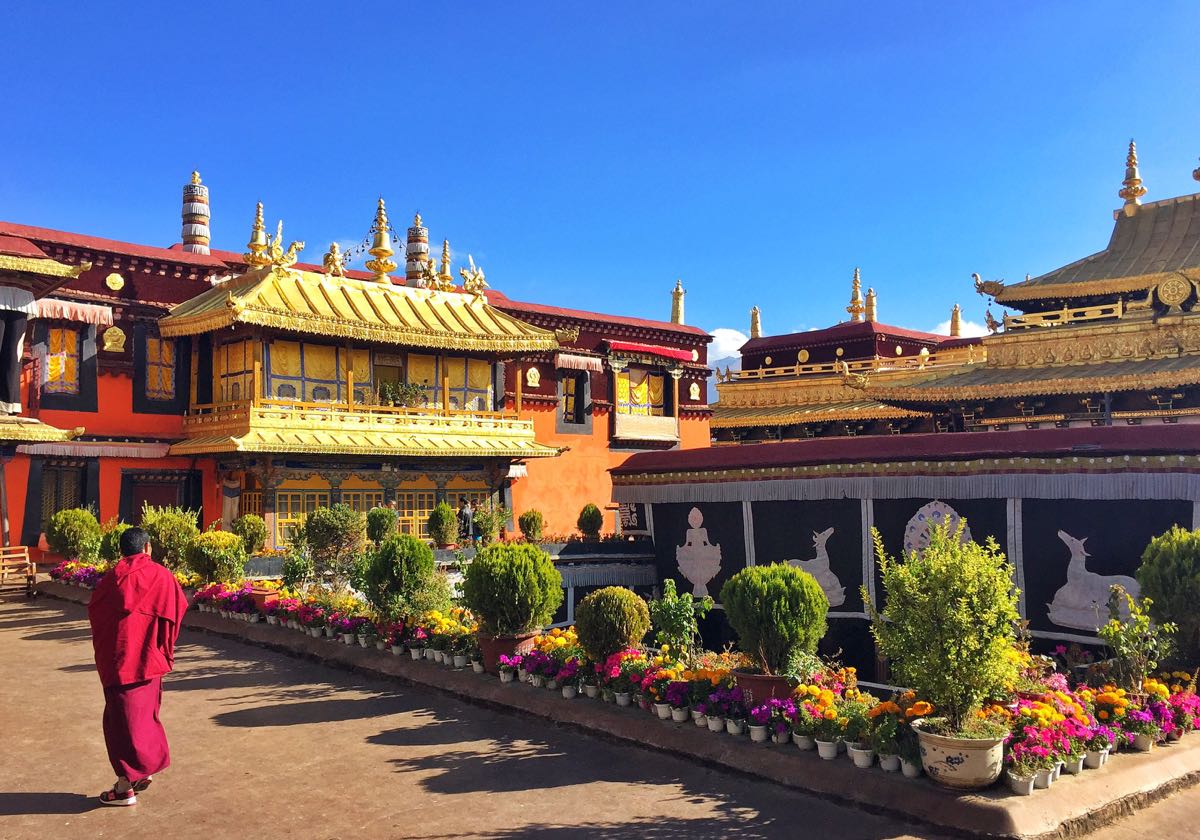 Jokhang Temple
Jokhang Temple
Chinese Name: Da Zhao Si (大昭寺)
Location: Lhasa City
Religious Status: The greatest spiritual pillar of Tibetan Buddhism
Year of the Initial Construction: 647 AD
Greatest Feature: The most splendid Tibetan Tubo Dynasty architecture
Treasure of the Temple: Statue of Sakyamuni at age of twelve
Jokhang Temple, located in the center of the old city of Lhasa, is a Tibetan Buddhist temple and an important heritage site under state protection. It has a history of 1350 years. It was built by Songzan Ganbu, the Tibetan king, to commemorate Princess Chizun's entry into Tibet, and then it was repaired and added to form a architectural complex. Jokhang Temple has a supreme position in Tibetan Buddhism. In November 2000, Jokhang Temple was listed in the World Heritage List as a World Cultural Heritage as an expansion project of Potala Palace.
Jokhang Temple is the most splendid Tubo period building in Tibet, and it is also the oldest existing civil structure building in Tibet. Jokhang Temple combines the architectural styles of Tibet, Tang Dynasty, Nepal, and India, and has become an eternal model of Tibetan religious architecture. Most monasteries in Tibet belong to a certain Tibetan Buddhist sect, while Jokhang Temple is a sacred temple respected by all sects.
When you have a deep understanding of Jokhang Temple, you will find that Jokhang Temple is not only the center of Lhasa’s geographical location but also the center of Lhasa’s people’s life and Tibetan culture. There are a large number of precious cultural relics preserved in Jokhang Temple, which provide abundant materials for Tibetan studies. All kinds of wood carvings and murals in the temple are exquisite, and the air is filled with ghee aroma. You can see Tibetans pay homage to the Sutra piously.
Samye Temple
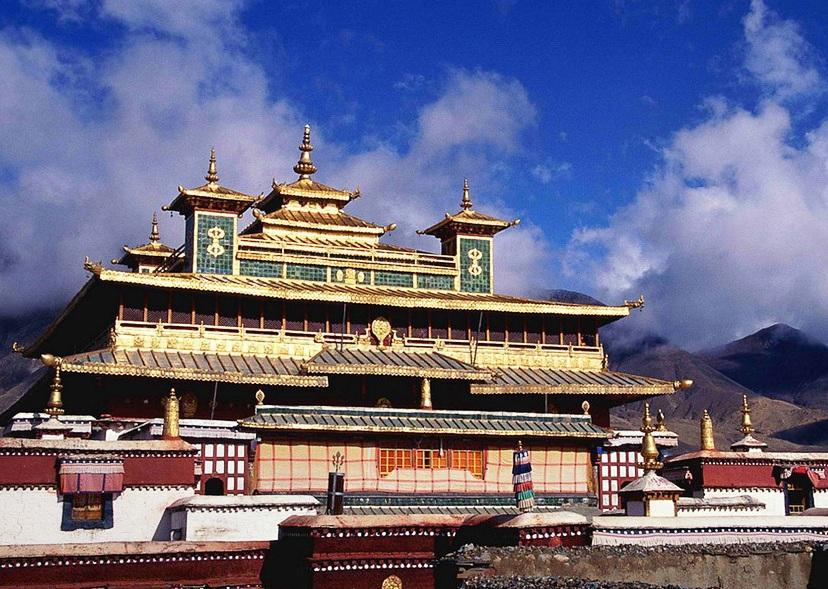 Samye Temple
Samye Temple
Chinese Name: Sang Ye Si (桑耶寺)
Location: Samye Town, Ngagzha County, Shannan
Religious Status: The first monastery in Tibet to have a tonsured monk
Year of the Initial Construction: 8th century AD during the Tubo Dynasty
Greatest Feature: The buildings in the temple are arranged according to the Buddhist view of the universe, and the central Buddhist hall has three styles of Tibetan, Han and Indian.
Samye Temple is located in the Shannan area of Zhanang County Yarlung Zangbo River north bank of Sangye Township, around the river cable, trees, and lush, dense forest. Samye Monastery has a history of more than 1,000 years since its founding. It is the oldest famous monastery in Tibetan historic sites and the grandest and most magnificent building in the Tubo period.
The temple treasures and preserves the history, religion, architecture, murals, sculptures, and other aspects of the heritage of various periods of Tibet since the Tubo Dynasty. It is one of the ancient and unique early cultural treasures of Tibet.
Drepung Monastery
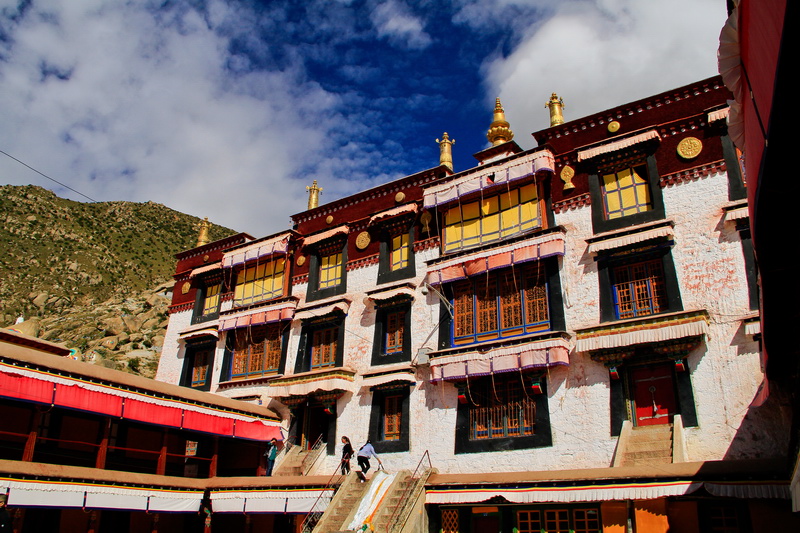 Drepung Monastery
Drepung Monastery
Chinese Name: Zhe Bang Si (哲蚌寺)
Location: Lhasa
Religious Status: The largest Buddhist monastery in the world, one of the six main temples of the Gelug, together with Gandan Monastery and Sera Monastery, is known as the three major temples of Lhasa.
Year of the Initial Construction: 1416 AD
Greatest Feature: The Shoton Festival covered the hillside with Buddha
In the first half of the 17th century, after the Fifth Dalai Lama expanded the temple, the development covered the entire slope of Genpei Wuzi Mountain, with nearly 10,000 monks at its peak. The most important building in the temple, the Tsochin Hall, covers an area of nearly 2,000 square meters.
Drepung Monastery has always had many famous monks. The first and fourth Dalai Lamas lived in Drepung Monastery, and the fifth Dalai Lama also lived here before he was conferred by the Emperor of the Qing Dynasty and moved to the Potala Palace.
There are many Buddhist events in Drepung Monastery, among which the biggest scene is the Shoton Festival. Every year on the 30th June of the Tibetan calendar, the monks of Drepung Monastery will hang a huge statue of Sakyamuni, 30 meters high and 20 meters wide, on the Genpei Wuzi Mountain for people to worship.
Ganden Monastry
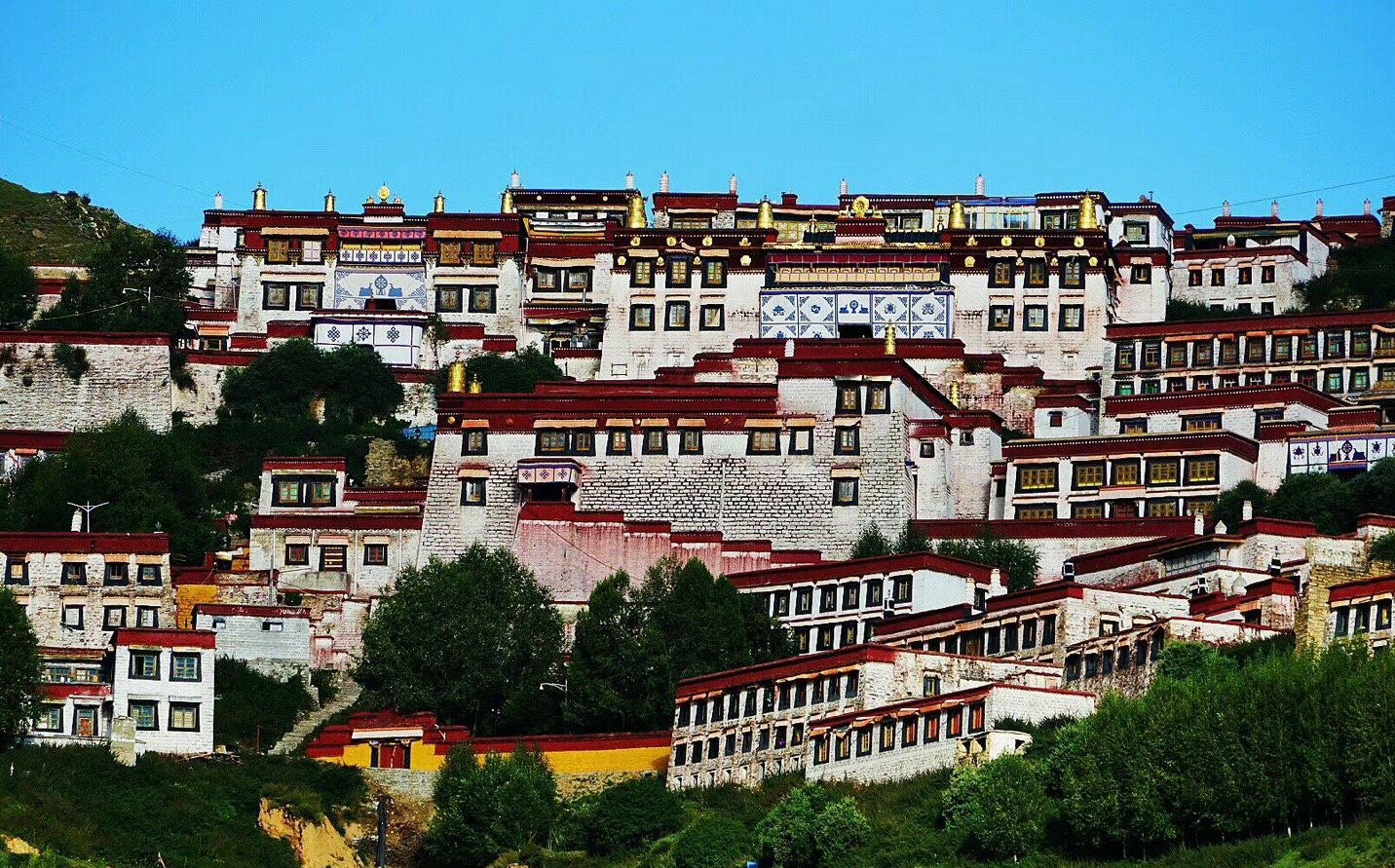 Gandan Monastery
Gandan Monastery
Chinese Name: Gan Dan Si (甘丹寺)
Location: Dazi District, Lhasa
Religious Status: Gelugpa Ancestral Temple built by Tsongkhapa, one of the six main temples of the Gelug, together with Gandan Monastery and Sera Monastery, is known as the three major temples of Lhasa.
Year of the Initial Construction: 1410 AD
Greatest Feature: Ganden Thangka Festival; The Buddha on the red wall of the Tsochin Hall
Treasure of the Temple: Kanjur sutra written in pure gold
Ganden Monastry not only occupies a crucial position in religion, politics, and architecture but also gathers a lot of art treasures such as armor given by Emperor Qianlong of the Qing Dynasty and brocade embroidered Tang by Emperor Yongle of the Ming Dynasty.
Every year on the fifteenth day of the sixth month of the Tibetan calendar, the Gandan Temple "Ganden Thangka Festival". Early in the morning, after the chanting of the monks of the temple, 16 young monks carried the big Thangka of Sakyamuni, which was 26 meters long and l0 meters wide, to the exhibition Buddhist platform for display, and half an hour later, it was collected and returned to the Yangbaqian Hall for collection. Then take out 24 pieces of brocade embroidery Tang to show around. At the same time, Tibetan opera, singing, and dancing will be performed.
Sera Monastery
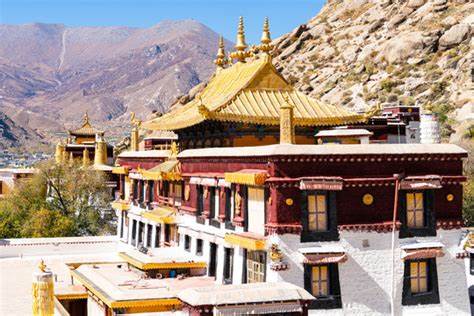 Sera Monastery
Sera Monastery
Chinese Name: Se La Si (色拉寺)
Location: Sela Road, Chengguan District, Lhasa
Religious Status: The second largest temple in Tibet; together with Gandan Monastery and Drepung Monastery, is known as the three major temples of Lhasa.
Year of the Initial Construction: 1419 AD
Greatest Feature: Debating sutras; The first Tibetan Tripitaka printed in block
Treasure of the Temple: The statue of Hayagriva
The debate of Sera Monastery has been well-known, and there are monks active in the debate field every day. Even though you can't understand what they are saying, sitting on the sidelines of the debate and watching the monks debate the sutras is also a kind of spiritual purification.
Sera Monastery also contains a wealth of precious cultural relics, such as the eighteen arhats of white sandalwood presented by Ming Emperor Zhu Di. In order to protect these arhats, Sera Monastery rebuilt 18 identical clay arhats and placed small sandalwood arhats inside the clay statues.
Pelkor Chode Monastery
Chinese Name: Bai Ju Si(白居寺)
Location: Gyantse Town, Gyantse County, Shigatze
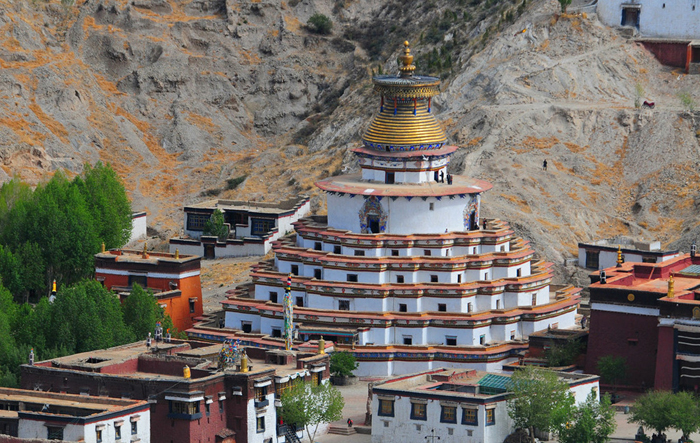 Pelkor Chode Monastery
Pelkor Chode Monastery
Religious Status: Sakya, Xialu and Gelug of Tibetan Buddhism coexist
Year of the Initial Construction:1427 AD
Greatest Feature: Pagoda combined with typical Tibetan Buddhist monastery architecture
Treasure of the Temple: Murals
Altitude: 3900m
Gyantse Kumbum (Bodhi Stupa), also known as "the ten thousand Buddha Pagodas", is the symbol of Pelkor Chode Monastery, built with nearly 100 Buddhist halls overlapping each other. It is the most magnificent building in Pelkor Chode Monastery. It is a nine-story pagoda with an octagonal shape. The pagoda has 108 doors, 76 Buddhist halls, and lintels decorated with elephants, lions, and flying dragons relief. It contains various Buddha statues, a total of more than 100,000 Buddha statues, and nearly 1,000 murals.
The murals of Pelkor Chode Monastery are also very famous, showing a wide range of themes, mainly including the life of the Buddha, Jataka Tales, etc., especially in painting methods are unique compared with many other temples in Tibet.
If you are interested in Tibetan Buddhism, do not miss this place. Come explore this temple full of history and culture!
Rongbuk Monastery
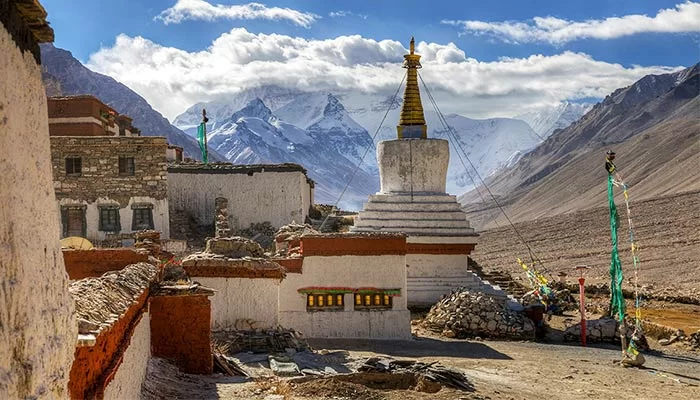 Rongbuk Monastery
Rongbuk Monastery
Chinese Name: Rong Bu Si(绒布寺)
Location: Basong Township, Tingri County, Shigatse
Year of the Initial Construction: 1899
Greatest Feature: The highest temple in the world. Excellent Everest viewing spot. The only temple in the world where monks and nuns live together.
Altitude: 5154m
Rongbuk Monastery was built on a mountain and has five floors. It is said that the temple was built here mainly because this place is quiet. Compared with the famous temples in Lhasa, it is small and even a little shabby, but the Buddha atmosphere you feel is no worse than those big temples and even adds some life atmosphere. Standing in the temple, you can see Mount Everest clearly on a good day. When Rongbuk Monastery was prosperous, it had more than 300 monks and 300 bhikshunis. It is dedicated to Buddha statues such as Sakyamuni and Padmasambhava. Ngawang Sangjie is the only monk at Rongbuk Monastery now and has been living here alone for more than 20 years. Ngawang Sangjie is here for the people who climb Everest to send blessings, and hope that each climber can return safely.
Every year on April 15th of the Tibetan calendar, Rongbuk Monastery holds three days of "the dance to god". According to legend, April 15th in the Tibetan calendar is the day of Buddha Shakyamuni's birth, enlightenment, and death. Therefore, a variety of activities are held during the month to commemorate, and over time these activities evolved into a festival with a grand scale of the spinning prayer wheels as the main activity.
Tsurphu Temple
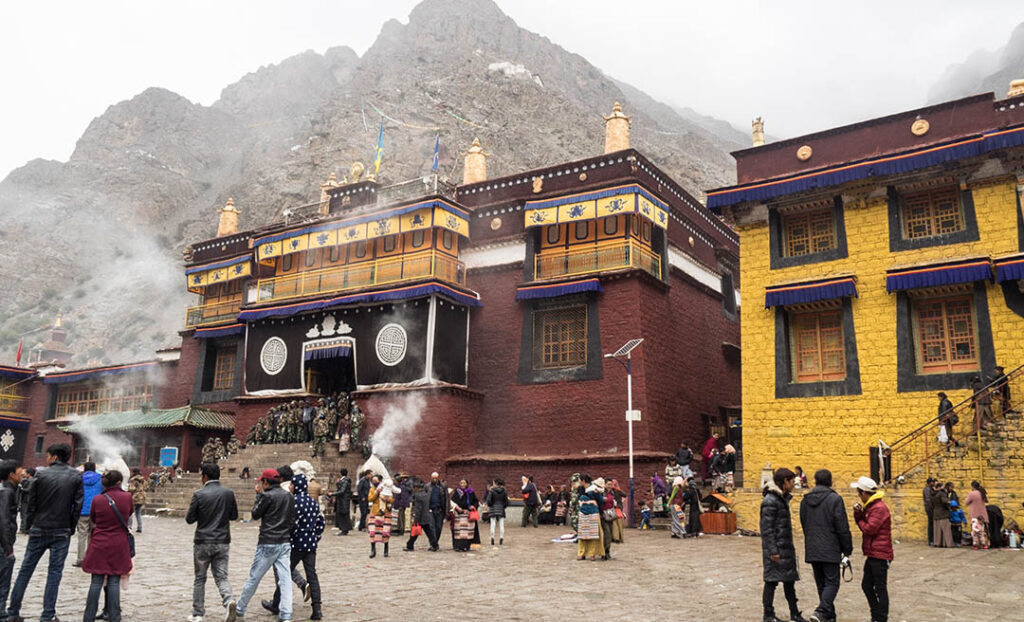 Tsurphu Temple
Tsurphu Temple
Chinese Name: Chu Bu Si(楚布寺)
Location: Doilungdêqên District, Lhasa
Altitude: 5154m
Year of the Initial Construction: 1189
Treasure of the Monastery: A silver statue created by the Eighth Karmapa in memory of his guru
Religious Status: The main temple of Karma Kagyu. The reincarnation system of living Buddhas in Tibetan Buddhism was pioneered here.
The large building complex of Tsurphu Temple is centered on the main hall, including the Sutras Hall, the Buddha Hall, the Dharma Protection Hall, the Buddhist college, the Tantric practice house, etc. The temple currently has more than 300 monks.
The second Karmapa Karma Pakshi was recognized as the reincarnation of the first Karmapa in this monastery. This was the beginning of the Tibetan Tulku Tradition.The temple has a collection of artifacts collected for centuries, engraved with ancient Tibetan language, which has important historical value for the study of politics, economy, and religion during the Tubo period.
There is a very elaborate temple was built behind Tsurphu Temple, named Gagang Temple, which was the main temple of the Goshir Gyaltsab Rinpoche. On the right of this temple are two small temples: Dratshang and Zuri, and the left side are Mahakali and Palden Lhamo.



































